#Cori Doerrfeld
Text
The new workplace: HELP MOM WORK FROM HOME
The new workplace: HELP MOM WORK FROM HOME @DianaMWrites @CoriDoerrfeld
@LittleBrownYR
Help Mom Work from Home!, by Diana Murray/Illustrated by Cori Doerrfeld (Oct. 2021, Little, Brown Books for Young Readers), $17.99, ISBN: 9780316273657
Ages 4-7
With more parents working from home than ever before, Help Mom Work from Home! is a fun, rhyming readaloud that speaks to the work-life balance. A mom is working from home and her little one is right next to her, modeling everything from…
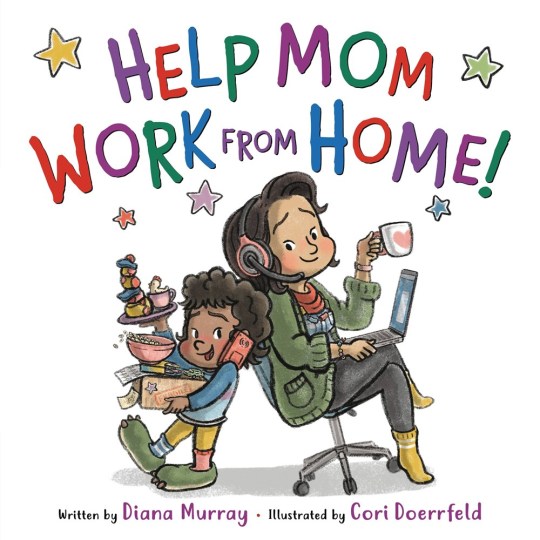
View On WordPress
#Cori Doerrfeld#Diana Murray#families#Help Mom Work from Home#Little Brown Books for Young Readers#rhyming#working at home
0 notes
Text

1 note
·
View note
Note
Top 5 books!
Oooo fun!! Okay because I’m an infant/toddler teacher/child therapist, I have a loooot of kids books and I want to include those 🥰 So it’ll mostly be those because it’s easier for me to remember (and I believe many adults need to read some of these kids books!!)
The Language of Flowers by Vanessa Diffenbaugh (I buy used copies that I can have on hand to give as gifts)
My Heart by Corinna Luyken — “tiny can grow and broken can mend and a heart that is closed can still open again.”
Over and Over by M.H. Clark (she’s my favorite children’s author—some other favorites are Everywere, Still; Maybe; You Belong Here; More Than a Little; and Tiger Days.
The Rabbit Listened by Cori Doerrfeld
Maybe by Kobi Yamada (and What Do You Do With a Problem?)
Ask me my top 5 anything!
#I also loooove the eragon series#and Love Alice by Barbara Davis#Plain Truth and Leaving Time both by Jodi Pocoult#but too hard to answer off the top of my head#oh and psych books hahah#wonderfulmarvels#answered#thanks for asking! 🩵
5 notes
·
View notes
Text
What to Say, and When to Say It, After the Next Tragedy
Helping young children cope with the unimaginable by providing guidance on what to say.
KEY POINTS
When it comes to discussing traumatic events with young children, there is no one answer to the question of what to say.
Listening is more important than talking since a child's inquiries will guide you to what knowledge they need and how much of it they require.
Reading may help youngsters better understand and connect to their emotions.

There is no requirement that you do it "correct."
There is no magic phrase to utter that will put everything right and make everything better. In addition, there is not much to be gained by attempting to compel a youngster to communicate before they are developmentally ready to do so. Allow some time to pass, maintain an open door policy, and create an environment in which they feel at ease discussing how they are feeling.
It might be useful to them if you sometimes talk about your own experiences.
Speaking one's mind is preferable to keep one's mouth shut.
Keeping quiet or ignoring the subject is tempting, but if you do so, you will be denying your kid the opportunity to comprehend and deal with the situation.
You don't want to leave the management of this situation up to babysitters who are angry.
It's not the conversation about what happened that's upsetting
it's the occurrences themselves, Take this into consideration as you get ready to have a conversation with your kids.
The news can make the situation even more severe.
The graphic pictures that we see on our electronic gadgets exponentially heighten our feeling of vulnerability, which is NOT something that our children need to experience or learn to manage.
You may listen to the news via your headphones or wait till they are sleeping.
Reading may help youngsters better understand and connect to their emotions.
Reading tales to young children and having conversations about how the children's favorite characters may be feeling is a great way to encourage youngsters to speak about their own emotions and concerns.
Books like "Once I Was Very Very Scared" by Chandra Ippen, "My Friend is Sad" by Mo Willems, "The Rabbit Listened" by Cori Doerrfeld, and "Lots of Feelings" by Shelley Rotner are some of my favorites for encouraging children to talk about and share their emotions. Other great books in this genre include "The Rabbit Listened" by Cori Doerrfeld.
4 notes
·
View notes
Text

The Rabbit Listened (Cori Doerrfeld)
#the rabbit listened#My flatmate made me listen to a read that her friend made of this story#Told me i am her rabbit#And i just#I don't have a rabbit for me#And i had a breakdown in front of her#So she put stromae's tiny desk concert to distract me#And the first song was l'enfer#And it was a very bad choice lmao she had to skip that one
0 notes
Text
2020 Picture Book Update


Images from my Goodreads page
My goodness. Picture books are taking over my life (but I’m not complaining). I am ahead on my two picture books a day because I tried to account for a few days by reading extra one day, then couldn’t control myself. But this is fantastic because I’ve read some truly amazing picture books! Here are my favorites from this update:
Henry and the Kite Dragon by Bruce Edward Hall & William Low (Illustrator): This is a historical fiction picture book! The artwork is beautiful and the narrative is full of kindness and compassion.
The Rabbit Listened by Cori Doerrfeld: I teared up when I read this book. It kind of hit home with my introverted nature as it’s about how to support hurting friends without being pushy.
Macca the Alpaca by Matt Cosgrove: This picture book just came out on February 4th! It’s hilarious with a super positive message in the end. Definitely check it out!
In a Jar by Deborah Marcero: *sigh* The power of friendship is in full blast with this picture book! Capture special moments in a jar then share them with those that need them!
The Sad Little Fact by Jonah Winter & Pete Oswald (Illustrator): This one hit home with society in general. The commentary about fact versus fiction (fake news) is strong with this picture book. This one will evoke feelings with readers of all ages.
A Place for Pluto by Stef Wade & Melanie Demmer (Illustrator): I loved this informative picture book about Pluto’s journey from planet to...what’s next? The artwork is quirky and cute but is great for conversations about science!
Please, please, PLEASE send me your picture book suggestions! I’m having so much exploring this world as an adult.
#picture books#book recommendations#bruce edward hall#william low#cori doerrfeld#matt cosgrove#deborah marcero#jonah winter#pete oswald#stef wade#melanie demmer#the bookish austin
7 notes
·
View notes
Photo
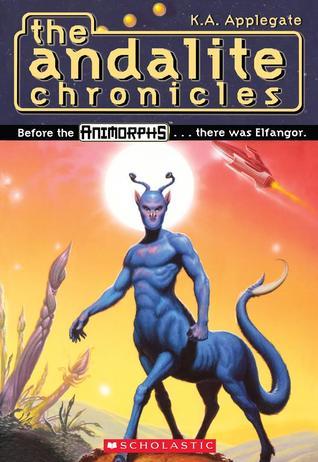



April Read This Month
Reviewed
Jacob Have I Loved/Katherine Paterson ★★★★ 4/5 (thoughts)
The Rabbit Listened/Cori Doerrfeld ★★ 2.5/5 (thoughts)
The Unknown/K.A. Applegate ★★★ 2.5/5 (thoughts)
The Knight at Dawn/Mary Pope Osborne ★★★★ 3.7/5 (review)
This Is How You Lose the Time War/Amal El-Mohtar and Max Gladstone ★★★ 3/5 (review)
Unreviewed
The Andalite Chronicles/K.A. Applegate ★★★★★ 5/5
Dinosaurs/Mary Pope Osborne and Will Osborne ★★★ 3/5
Dead Wake: The Last Crossing of the Lusitania/Erik Larson ★★★★ 4.4/5
The Change/K. A. Applegate ★★★★ 4/5
A House That Once Was/Julie Fogliano, illustrated by Lane Smith ★★★★ 4/5
Doomsday Book/Connie Willis ★★★★ 3.7/5
Betsy and the Great World/Maud Hart Lovelace ★★★★ 4/5
Rereads
James Herriot’s Cat Stories
Smile/Raina Telegemeier
DNF
Trail of Lightning/Rebecca Roanhorse
#april#april 2020#mine#2020#rtm#wrap up#booklr#read this month#april rtm#april read this month#2020 rtm#2020 read this month#books
1 note
·
View note
Photo

21 Children's Books That Teach Empathy And Kindness
[via huffpost.com]
Parents today are very concerned about raising kids who will be forces for good in the world. There are many ways to teach children empathy and understanding, and one very simple yet powerful approach is through books.
Here’s a selection of diverse books that feature messages of empathy and kindness.
Last Stop on Market Street by Matt de la Pena
Those Shoes by Maribeth Boelts
Most People by Michael Leannah
The Invisible Boy by Trudy Ludwig
Little Blue Truck by Alice Schertle
Be Kind by Pat Zietlow MIller
Save Me a Seat by Sarah Weeks and Gita Varadarajan
If You Plant a Seed by Kadir Nelson
One by Kathryn Otoshi
We're All Wonders by R.J. Palacio
I am Enough by Grace Byers
Enemy Pie by Derek Munson
Lovely by Jess Hong
A Sick Day for Amos McGee by Philip C. Stead
Have You Filled a Bucket Today? by Carol McCloud
Each Kindness by Jacqueline Wilson
I Walk With Vanessa by Kerascoet
The Monster Who Lost His Mean by Tiffany Strelitz Haber
The Rabbit Listened by Cori Doerrfeld
Otis and the Scarecrow by Loren Long
The Story of Ferdinand by Munro Leaf
...
Click through to see more titles.
9 notes
·
View notes
Text
Good Dog by Cori Doerrfeld
Good Dog by Cori Doerrfeld is a fun story for animal lovers, especially dog lovers. Readers will enjoy following the story of a lonely stray dog looking for his forever home. He finds a little girl that he wants to befriend and follows her. When he realizes that she's lost her favorite toy, he knows he must bring it to her. Readers will enjoy this heartwarming tale of a little girl with man's best friend.
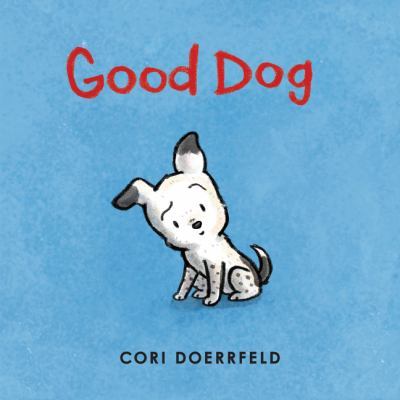
This story shows children how reading and talking fosters vocabulary and background knowledge. The author only writes two words on each page of the story—one of the words being “dog”. By using such simple text, readers increase their vocabulary by learning words that describe the dog. Parents can ask their children to repeat the words aloud and explain what they mean.
The story increases a child's background knowledge through the use of pictures and words. Parents can ask their children what they think a word means; if a child doesn't know, they can simply use the pictures for context clues. Children will build a better understanding of narrative skills or knowing how stories work through the dog's adventures.
Tips for Reading:
As you read the story, ask your children what they think each word means that describes the dog. If the child is very young, have them repeat the word aloud and explain its meaning through the pictures.
#good dog#cori doerrfeld#reading#talking#vocab builder#background knowledge#narrative skills#ecrr extension activities#preschool books#kids' books#parenting
0 notes
Link
Our favorite childhood stories tend to stick with us. For me, rabbits seemed to be prominent characters in the books I loved – from Uncle Wiggily to Watership Down, Peter Rabbit and Alice in Wonderland. And more than the adventures of the bunnies, I remember the way the stories made me feel, and the lessons I still carry with me. There were lessons of survival, persistence, curiosity, risk-taking, and problem-solving that reinforced values of leadership, compassion, community, respect, and kindness. These rabbits live on in my subconscious, holding power and space having shaped my understanding of the world and all of its love and pain. Now, as a parent, I’ve come to know just how critical these choices are for my own children, and just how much power a simple picture book can hold.
Enhancing Social Justice Literacy
In 2015, Tanya Nixon-Silberg and Francie Latour, two Black mothers, authors, and community activists, drew on their own parenting practices – especially their use of children’s books to disrupt dominant narratives with their kids – to launch Wee the People (WTP) in Boston. WTP is a social justice project for children aged 4-12 that explores activism, resistance, and social action through the visual and performing arts. As part of their work, WTP hosts Social Justice Storytime at the Boston Public Library for their “Little Voices, Big Changes” initiative, built on the belief that if kids can understand fairness they can understand justice. Tanya and Francie work to builds parents’ capacity to confront topics like racism, deportation, gentrification, misogyny, islamophobia, and homophobia.
Innosanto Nagara, a Southeast Asian immigrant father, author/illustrator, and graphic designer creates new-wave board books that inspire conversations about social justice and encourage children’s passion and action around social causes like environmental issues, LGBTQ rights, and civil rights. With titles like A is for Activist, Counting on Community, and The Wedding Portrait, Innosanto explores themes of activism, free speech, political progress, civil disobedience, and artistic defiance. Innosanto is on the editorial team of M is for Movement, a site dedicated to exploring social justice and activism in children’s literature. The contributors to M is for Movement are children’s writers, illustrators, and book creators who are long-time activists and advocates who “come from and stand with marginalized communities living at intersections of identity, experience, race, class, gender, religion, sexuality, and ability.”
At the 2018 Facing Race National Conference in Detroit organized by Race Forward, Wee the People co-founder Tanya Nixon-Silberg and author/illustrator Innosanto Nagara presented a workshop together on racial literacy for children. They stressed the importance of racial literacy from an early age in the process of dismantling racist systems and structures.
Through their work, Tanya, Francie, and Innosanto are invested in inspiring social action through the arts, and have found that children’s books offer a powerful medium for moving new generations of people towards justice. Louise Derman-Sparks from Social Justice Books (a project of Teaching for Change) agrees:
“Children’s books continue to be an invaluable source of information and values. They reflect the attitudes in our society about diversity, power relationships among different groups of people, and various social identities (e.g., racial, ethnic, gender, economic class, sexual orientation, and disability). The visual and verbal messages young children absorb from books (and other media) heavily influence their ideas about themselves and others. Depending on the quality of the book, they can reinforce (or undermine) children’s affirmative self-concept, teach accurate (or misleading) information about people of various identities, and foster positive (or negative) attitudes about diversity. Children’s books teach children about who is important, who matters, who is even visible” (Guide for Selecting Anti-Bias Children’s Books, 2013).
Social Justice Literacy as a Prevention Strategy
Social justice literacy is an effective gender-based violence prevention strategy – a proactive effort to stop violence and abuse from happening in the first place by interrupting the cultural rules, norms, and constructs that support it. Several projects highlighted in the PreventIPV Tools Inventory demonstrate the effectiveness of social justice literacy in creating a more peaceful and just world. For example, Teaching for Change is a project that strives to build a more equitable, multicultural society by promoting social justice activism in the classroom. Their strategies center on leadership development and civic engagement for students, parents, and teachers that draw on real world current events. Teaching a People’s History offers classroom materials that emphasize the role of working people, women, people of color, and organized social movements in shaping history. And Rethinking Schools focuses on strengthening public education through social justice teaching and education activism with a specific focus on promoting equity and racial justice in the classroom. These approaches focus on impacting the outermost layers of the social ecology to shift our cultural norms and values.
Priya Vulchi and Winona Guo, youth activists and creators of The Classroom Index, a textbook on racial literacy, identified two gaps in racial education:
The heart gap: “An inability to understand each of our experiences, to fiercely and unapologetically be compassionate beyond lip service,” and
The mind gap: “An inability to understand the larger, systemic ways in which racism operates.”
TED Talk: What It Takes to be Racially Literate by Priya Vulchi and Winona Guo
Children’s literature is one way to bridge these gaps by inspiring, educating, and engaging readers of all ages in a deeper understanding of the lived experiences of all people, families, and communities in our wide and vibrant world. But the fact is that marginalized people and communities are outrageously underrepresented in books available to children in mainstream American classrooms, libraries, and catalogues – in terms of both those authoring the books, and characters represented inside them. The Cooperative Children’s Book Center found that in all children’s picture books published in 2015, you are more likely to find non-human characters like bunnies (12.5%) than African Americans (7.6%) and Latinx (2.6%) combined. White characters are primarily depicted in the vast majority (73.3%) of these books.
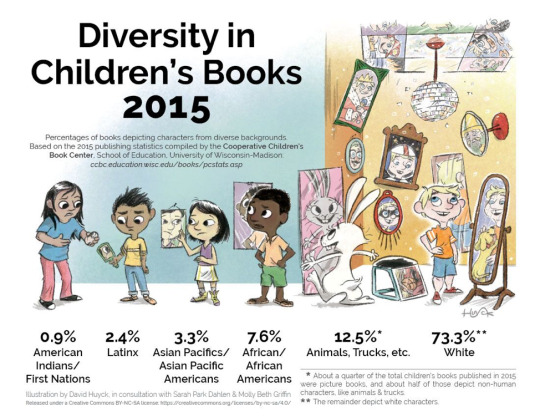
Illustration: Diversity in Children's Books 2015 by David Huyck, in consultation with Sarah Park Dahlen and Molly Beth Griffin
Social Justice Books serves to identify, vet, and promote multicultural and social justice children’s books, building on the tradition of the Council on Interracial Books for Children which offered a social justice lens to reviews of children’s literature. They also help parents and children develop critical literacy skills and promote activism around diverse representation in libraries. One example is their #StepUpScholastic campaign urging Scholastic to “publish and distribute children’s books that reflect and affirm the identity, history, and lives of ALL children in our schools.” Engaging children in proactive efforts to both notice and address the underrepresentation of people of color in literature, as illustrated above, builds their social justice literacy.
Books that Promote Justice and Peace
For those looking for books that promote justice and peace, resources like Social Justice Books offer vetted booklists on a variety of topics, as do Raising Luminaries: Books for Littles and Little Feminist: Books for raising conscious kids. Topics include:
Learning about family structures
Talking to kids about violence
Books for tomorrow’s leaders
Honoring single mothers
Promoting healthy fatherhood
Fostering social and emotional health, compassion, and independence
Helping kids recognize privilege
Cultivating healthy sexual boundaries
Preventing sexual violence
Bullying, civil disobedience, and disrupting injustice
Seek out books by authors of color like Newbery Medal and Coretta Scott King Honor receipient Kwame Alexander. Additionally, several anti-violence organizations offer book lists specific to addressing trauma. For example, The Child Witness to Violence Project offers books about trauma and violence for young children.
As M is for Movement explains, “Children’s literature—both fiction and nonfiction—is full of inspiration and examples of children and adults who stand up for themselves and others. Whether it’s ducks organizing animals to oppose unfair farm rules, a student listening to her classmates’ concerns when running for student council, or a boy joining his first march, young people’s literature can demonstrate how individuals and communities have the power to act as agents for social change.”
Through children’s books, we can teach justice and peace across generations. By engaging a child in a book with a strong message that fills the heart and the head, we can help build their understanding, compassion, and confidence to impact social change in ways that are meaningful and important to them. And these lessons and values will likely stick with them their whole life long
Images:
The Rabbit Listened by Cori Doerrfeld
Counting on Community by Innosanto Nagara
Illustration: Diversity in Children's Books 2015 by David Huyck, in consultation with Sarah Park Dahlen and Molly Beth Griffin
2 notes
·
View notes
Text
Top picks of 2018 from our staff!
We asked our staff to pick their top 5 favorite books from 2018 and they delivered! Well, there was a lot of “ONLY FIVE?!?!?!” going around, but eventually stacks were gathered (spoiler: some are 6 books high. Booklover life is hard).
Here they are!

18th St store manager Elena’s picks:
A Pop-up Guide to Hogwarts by Matthew Reinhart
We Don’t Eat Our Classmates by Ryan T. Higgins
Bygone Badass Broads by Mackenzi Lee
Be Prepared by Vera Brosgol
Dear Rachel Maddow by Adrienne Kisner

18th St assistant manger TJ’s picks:
This is Kind of an Epic Love Story by Kheryn Callender
The Rabbit Listened by Cori Doerrfeld
The Brilliant Death by Amy Rose Capetta
The Serpent’s Secret by Sayantani DasGupta
Seeing Stars by Sara Gillingham
Dread Nation by Justina Ireland

YA Buyer & Events Coordinator Eileen’s picks:
Dry by Jarrod & Neal Shusterman
Furyborn by Claire Legrand/Sawkill Girls by Claire Legrand (choices are hard)
Unbroken edited by Marieke Nijkamp (w/ 12 other contributors!)
Anger is a Gift by Mark Oshiro
The Astonishing Color of After by Emily X.R. Pan
Seafire by Natalie C. Parker
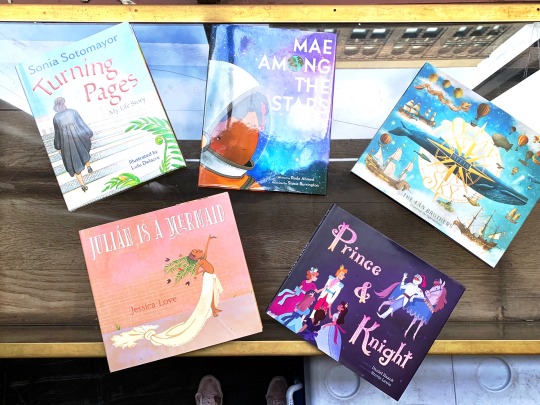
18th St Bookseller Rayan’s picks:
Turning Pages by U.S. Supreme Court Justice Sonia Sotomayor
Mae Among the Stars by Roda Ahmed, illustrated by Stasia Burrington
Ocean Meets Sky by The Fan Brothers
Julian is a Mermaid by Jessica Love
Prince & Knight by Daniel Haack, illustrated by Stevie Lewis

18th St Bookseller Nadja’s picks:
Louisiana’s Way Home by Kate DiCamillo
The Truth As Told By Mason Buttle by Leslie Connor
In the Land of Happy Tears: Yiddish Tales for Modern Times: collected & edited by David Stromberg
The Right Hook of Devin Velma by Jake Burt
The Penderwicks at Last by Jeanne Birdsall

84th St Bookseller Cass’s Picks:
Chaotic Good by Whitney Gardner
The Spy with the Red Balloon by Katherine Locke
Fake Blood by Whitney Gardner (they really love Whitney)
Check Please by Ngozi Ukazu
Keeper of the Lost Cities: Flashback by Shannon Messenger

84th St Bookseller Clare’s picks:
National Parks of the U.S.A. by Kate Siber, illustrated by Chris Turnham
The Poet X by Elizabeth Acevedo (National Book Award winner!)
City of Ghosts by Victoria Schwab
Bygone Badass Broads by Mackenzi Lee (that’s 2 votes for this book!)
Drawn Together by Minh Le, illustrated by Dan Santat
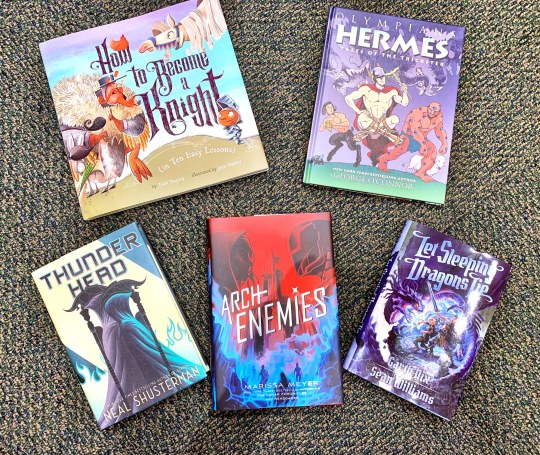
84th St Bookseller Sarah’s picks:
How to Become a Knight (In Ten Easy Lessons) by Todd Tarpley, illustrated by Jenn Harney
Olympians: Hermes, Tales of the Trickster by George O’Connor
Thunderhead by Neal Shusterman
Archenemies by Marissa Meyer
Let Sleeping Dragons Lie by Garth Nix & Sean Williams

18th St Bookseller Monique’s picks:
Harriet Gets Carried Away by Jessie Sima
Ocean Meets Sky by The Fan Brothers (that’s 2 votes on this one!)
The Remember Balloons by Jessie Oliveros, illustrated by Dana Wulfekotte
The Day You Begin by Jaqueline Woodson, illustrated by Rafael Lopez
Crunch the Shy Dinosaur by Cirocco Dunlap, illustrated by Greg Pizzoli

84th St Assistant Manager Kellie’s picks:
Presto & Zesto in Limboland by Arthur Yorinks & Maurice Sendak
Making Friends by Kristen Gudsnuk
Rosie Revere & the Raucous Riveters by Andrea Beaty
Ogre Enchanted by Gail Carson Levine
What If It’s Us by Becky Albertalli & Adam Silvera
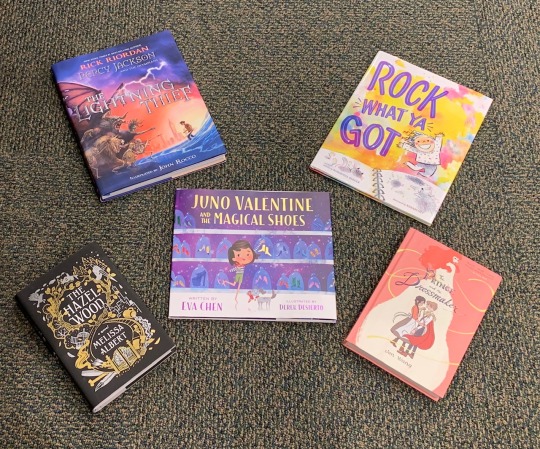
84th St Bookseller Rhianna’s picks:
Percy Jackson & the Olympians: The Lightning Thief, the Illustrated Edition by Rick Riordan, illustrated by John Rocco
Juno Valentine & the Magical Shoes by Eva Chen, illustrated by Derek Desierto
Rock What Ya Got by Samantha Berger, illustrated by Kerascoet
The Hazel Wood by Melissa Albert
The Prince & the Dressmaker by Jen Wang

18th St Keyholder Olivia’s picks:
Pride by Ibi Zoboi
Hurricane Child by Kheryn Callender
Burning Magic (A Shadow Magic Novel) by Joshua Khan
Furyborn by Claire Legrand (That’s 2 votes for this books!)
Can I Be Your Dog? by Troy Cummings
Dance of Thieves by Mary E. Pearson
What were your faves from 2018???
#top books#best of 2018#staff picks#staff rec#booklife#booklove#bookstore#indiebookstore#books of wonder#bibliophile#booknerd#bookworm#alwaysreading#currently reading#faves#picture books#middle grade#ya#yalit#i love ya#i read ya#young adult#kidlit#children's books#childrensliterature#childrensbookstore#nycbookstores#booksellers
1 note
·
View note
Text

excerpt from The Rabbit Listened by Cori Doerrfeld
0 notes
Text
Jack Frost
COVID-19 this week:

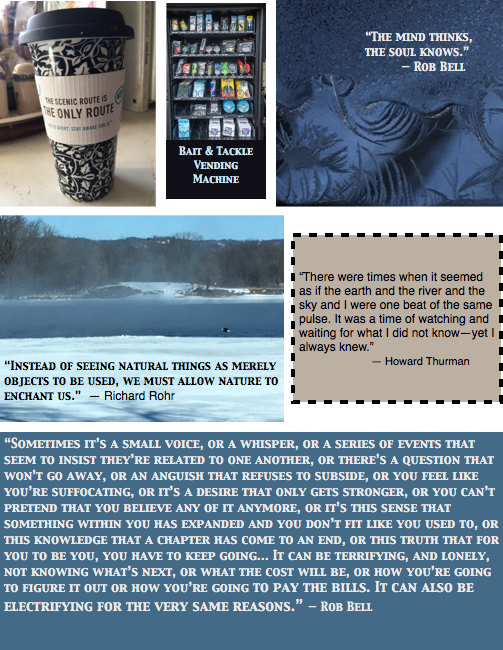



On The Drive
How many drive-by’s happened before I got the joke at the bar sign along the Great River Road? I am uncertain. But this last drive over the weekend must have hit the jackpot. The mental stars were all aligned. Seeing the sign, again, and a slow chuckle begins to emerge as we drive past it. Regaining more highway speed as we head up the hill and out of town. The quick “out of the corner of my eye” look begins to jell. Recognizing what I have just retrieved. Knowing these COVID-19 days I am truly working on different cylinders and faster is not the speed. The hazard of this pandemic’s longevity.
But, no matter. Back to the road and the sign and the recognition of its intent. It hits me. The joke that had been waiting for me to find it. Sharing the slow-mo discovery with my traveling companion while I am ha, ha’ing myself into it. “Tomorrow” --- the day that never comes. So actually there is no “Free Beer” ever. What a steal deal. It does grab my attention, which is what any good road sign designer hopes to accomplish. Acknowledging that we are always living in the present. Tomorrow becomes a yesterday after a series of present days have passed. But tomorrow never actually comes, for when we are in the new day it is not a “tomorrow” but it has become a “today.” Messing with my mind here. Love the humor. Taking a while for the sink-in to happen. Blaming it on the pandemic. The speed with which my brain is able to garner what I may have missed once, or possibly twice before. Thinking it may seem funnier the slower it takes to register.
Then further down the road, another visual catches my eye and stays. We were just leaving a newly found favorite spot. A place where with rapt attention I had just been witness to some thirty or so eagles as they took turns dancing and swooping with poetic ease while in flight. Some dove towards the water, talons poised for the quick fish grab attempt as we sat along the sidelines in view of the open Mississippi water near Lock and Dam #4 in Alma. Deciding to continue on our travels we turn around on the road to head back north to cross the bridge, making our way to Wabasha and the Eagle Center. That is when I spot it. “It” being a bait and tackle vending machine. My mind begins to spin. It totally doesn’t compare to the majesty of the eagles, but it does begin to unleash something new. Sparking questions. What can you buy in such a machine? What exactly is tackle in that context? Obviously not live bait, so what — rubber worms? The questions stay with me even as we cross over the bridge.
Finding that these weekend adventures amuse and entertain me over and again. Seeing things anew even though the road may be familiar. Looking more deeply at what is right in front of me with a curiosity to ask more of the questions that seem to spontaneously spring up, adding refreshing nourishment for my parched quarantined spirit. +++



Resources:
“Finding Peace While Grieving” by Caren Stelson and Ellie Roscher, February 12, 2021: Read 📝
“A 12-Year-Old’s Letter to Her Post-Pandemic Self” by Julia Cho, New York Times, December 30, 2020: Read 📝
The Rabbit Listened by Cori Doerrfeld 📙
Uncomfortable Conversations with a Black Man: Karens & Cancel Culture: Emmanuel Acho 📽

0 notes
Text
The rabbit listened | Cori Doerrfeld
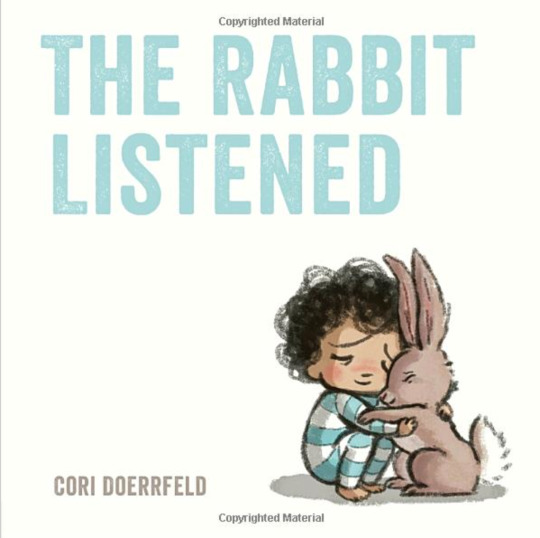
Intro:
When something sad happens to Taylor, all the animals think they know how to help.
One by one they come, but nothing they say makes Taylor feel better.
Until the rabbit arrives . . . and the rabbit knows just what to do.
With its spare, poignant text and irresistibly sweet illustrations, The Rabbit Listened is about healing heartaches big and small, and taking the time to listen.
--
One day, Taylor decided to build something.
Something new.
Something special.
Something amazing.
Taylor was so proud.
But then, out of nowhere . . .
things came crashing down.
The chicken was the first to notice.
“Cluck, cluck ! What a shame !
I'm so sorry, sorry, sorry this happened !”
“ Let's talk, talk, talk about it! Cluck, cluck!”
But Taylor didn’t feel like talking.
So the chicken left.
Next came the bear.
“Grarr! Rarr! How horrible! I bet you feel so angry!
Let's shout about it! Garr! RARRRR!GARRRR!”
But Taylor didn't feel like shouting.
So the bear left.
The elephant knew just what to do.
“Trumpa-da! I can fix this!
We just need to remember exactly the way things were.”
But Taylor didn't feel like remembering.
So the elephant also left.
One by one, they came.
The hyena: “ Hee-hee!
Let's laugh about it!”
The ostrich:”Gulp"
Let's hide and pretend
nothing happened!”
The kangaroo:” Tsk tsk.
What a mess! Let's throw
it all away!”
And the snake:” Shhhhh.
Let'ssss go knock down
someone else'ssss.”
But Taylor didn't feel like doing
anything with anybody.
So eventually, they all left . . .
until Taylor was alone.
In the quiet, Taylor didn't
even notice the rabbit.
But it moved closer,
and closer.
Until Taylor could feel
its warm body.
Together they sat in silence
until Taylor said,
“Please stay with me.”
The rabbit listened.
The rabbit listened as
Taylor talked.
The rabbit listened as
Taylor shouted.
The rabbit listened as
Taylor remember . . .
and laughed.
The rabbit listened to Taylor's
plans to hide . . .
to throw everything away . . .
to ruin things for someone else.
Though it all, the rabbit never left.
And when the time was right, the rabbit listened
to Taylor's plan to build again.
“I can't wait, “ Taylor said.
“It's going to be amazing.”
#book #blue_white #picture_book
0 notes
Text
2020 Picture Book Update
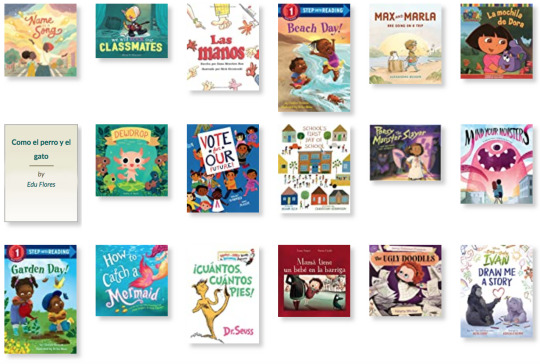
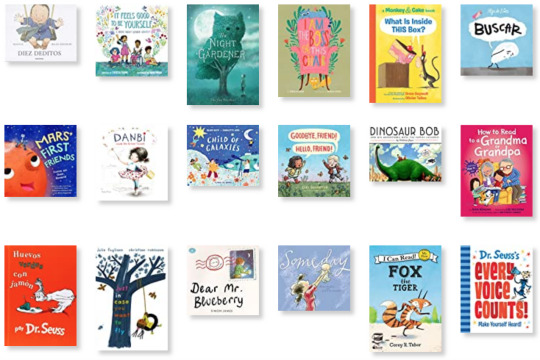
Images from my Goodreads page
I’m still over here working on reading two picture books per day in between all the other reading I want (need?) to do. :) Reading these picture books always warms my heart and they are a special spark for each and every day. I highly suggest you try to read a few a week if you want to experience all this goodness. Who says picture books are just for kids? :)
Here are a few of my favorites from the past few weeks:
Dewdrop by Katie O’Neill: Dewdrop is the most adorable axolotl I have ever seen. They are also the most supportive friend you’ll ever witness! This book is full of so much love and compassion that I think it should be a staple for all kids.
Goodbye, Friend! Hello, Friend! by Cori Doerrfeld: Have the kids in your life ever had a big change where they had to leave friends or friends left them? This book helps children understand that people come and go but the experiences we have with them are forever in our memories.
Vote for Our Future by Margaret McNamara (Author) & Micah Player (Illustrator): In this day and age, it is never too early to discuss politics with children. This book highlights why it’s important for kids to learn about voting as well as promoting political awareness in your community. If the decisions of adults affect children, why can’t they speak up as well?
Your Name is a Song by Jamilah Thompkins-Bigelow (Author) & Luisa Uribe (Illustrator): This book is going to lift up every child, no matter their name, to know that THEY are unique and THEIR name is beautiful - no matter its origin or pronunciation. The girl in this book is upset that her name is constantly mispronounced, so her mother teaches her the beauty and musicality in names from all types of cultural backgrounds.
What books do you think I should read? I would greatly enjoy hearing from you so please don’t hesitate to message me here on Tumblr, on my Instagram, or on Goodreads! Be safe and healthy out there readers. <3
2 notes
·
View notes
Photo

The story “The Rabbit Listened” written and illustrated by Cori Doerrfeld is a story about how a young child named Taylor had a bright imagination of building something big then ever imaginable, until birds swooped down and destroyed it. Since that tragic incident, all this child wanted was a friend to express their emotions and feelings to. Throughout Taylor’s quest to find that companionship with a friend, this character found that out all the animals included in this story, the rabbit was the only one who took the time to listen.
What appealed to me about this book is that it gives children a broadened schema of real life lessons they can learn from and take with them through every milestone in their life. For example, students may be in situations where there with their friends, and one of them is feeling down about something that has occurred in their life and they learn how to be that companion and “shoulder to cry on”. Throughout the text, I notice how there is a continuing pattern of each animal coming in to try and help Taylor express emotions and why this main character was feeling so upset. Each animal communicates a variety of different perspectives in which to try and help Taylor. “The chicken was the first to notice. Cluck, cluck! What a shame! I’m so sorry, sorry, sorry this happened! Let’s talk, talk, talk about it! Cluck, cluck! But Taylor didn’t feel like talking. So the chicken left. Next came the bear. Grarr Rarr! How horrible! I bet you feel so angry! Let’s shout about it! Garrr! RARRR! GRAAAAR! But Taylor didn’t feel like shouting. So the bear left” (Doerrfeld, 2018, 10-16). Students will learn as they read along to the story, that each of the animals, weren’t the “listeners” and didn’t allow or give Taylor the opportunity to talk about what just happened at the beginning of the story.
As I’m analyzing each page in the text, I notice how the author writes simplistic sentences or statements, ways in which students can understand, as well as illustrates pictures that corresponds to the description. This will help students understand what the visual illustrations symbolize, which will enhance emergent reading and writing. Teacher moves this would be supporting is “guiding students into helping them build a strong sense of understanding meaning” (Fantozzi, 2020, slide 2). Teachers are also “supporting a child’s schema by adding their own language and experiences” (Fantozzi, 2020, slide 5). They can also invite students to express their stories and add language about when they were ever that “rabbit” for a friend, whether it was for something exciting that happened to them or something they are having a hard time with. The author illustrates each picture in the book distinctively, meaning that there is only one main character (Taylor) in the story and one protagonist (the rabbit). This will help and support emergent readers, because students are learning step-by-step the main elements that make up a story (a main character, protagonist, and antagonist), as well as what each of them symbolize in the story, through the quality of what they’re saying.
As I read through towards the end of this story, I come across this meaningful passage that I feel exemplifies the meaning and message of this book that students can really take away with them. “In the quiet, Taylor didn’t even notice the rabbit. But it moved closer, and closer. Until Taylor could feel it’s warm body. Together they sat in silence until Taylor said, “Please stay with me”. The rabbit listened. The rabbit listened as Taylor talked. The rabbit listened as Taylor shouted. The rabbit listened as Taylor remembered… and laughed. The rabbit listened to Taylor’s plans to hide… to throw everything away… to ruin things for someone else. Through it all, the rabbit never left. And when the time was right, the rabbit listened to Taylor’s plan to build again. “I can’t wait,” Taylor said. “It’s going to be amazing”” (Doerrfeld, 2018, 23-32).
0 notes